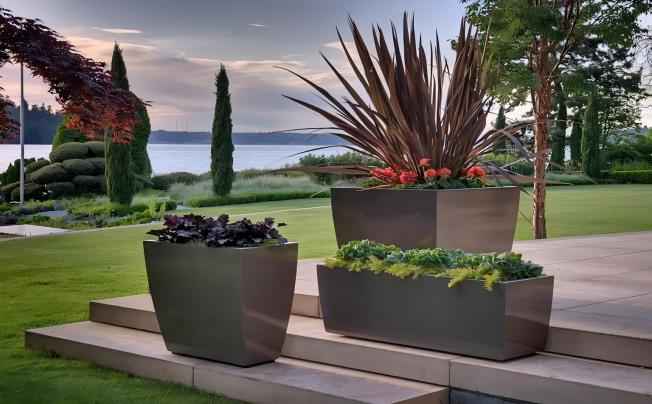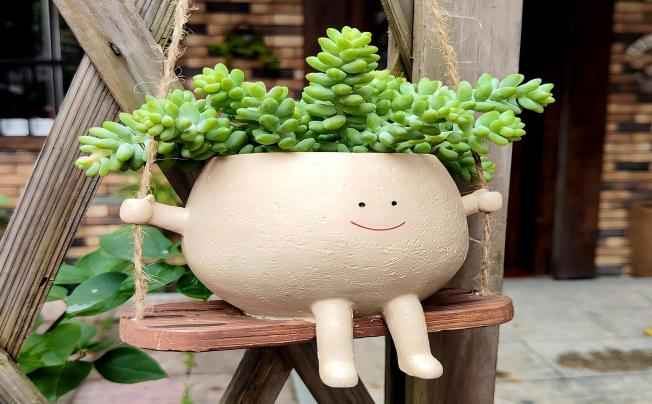What Is The Healthiest Material For Planters?
One important factor is the flowerpot's material. It has a direct impact on the growing conditions for the plant roots in addition to the flowerpot's aesthetic appeal and longevity. Everything is directly tied to the plant's health, from drainage and air permeability to temperature control.
Key considerations for healthy flower pot materials
(I) Permeability of air
A plant's root system is comparable to a person's lungs. For it to get the energy required for growth, it must breathe. The root system cannot breathe easily if the flower pot's air permeability is low. Long-term hypoxia can weaken the root system and perhaps lead to rot, which will have an impact on the overall health of the plant. Succulents, for instance, have very high air permeability requirements. Its root system may fully breathe, flourish, and produce plump, juicy leaves in a flower pot with good air permeability; if it is placed in a flower pot with poor air permeability, the root system will rot easily from a lack of oxygen, which will cause the plant to wither.
(II)Drainage
Plants require the right quantity of water to flourish, but too much water buildup can kill the root system. Poor drainage in the flower pot prevents the extra water from being released in a timely manner, which causes it to pool at the bottom. This long-term overhumidification of the soil causes hypoxia in the roots, which prevents them from breathing and absorbing nutrients as they should. The health of plants is further jeopardized by a humid atmosphere, which is also conducive to the growth of bacteria and fungus that cause a variety of illnesses and pests.
(III) Stability of chemicals
When used, chemically stable materials won't release toxic compounds like heavy metals or other chemicals, poison plant roots, or let harmful substances seep into the soil while watering, all of which can hinder plant growth. At the same time, chemically stable materials can guarantee that there is no possible risk to human health when it comes to flower pots used for indoor gardening or growing edible plants.
Inventory of common flower pot materials
1. Flower containers made of plastic
One of the most popular varieties of flower pots available is made of plastic. They are reasonably priced, making them a cost-effective option for gardeners on a tight budget. They are portable, lightweight, and easy to transport. Plants are simple to use whether they are placed on windowsills, balconies, or as interior décor. Additionally, plastic flower pots come in a wide variety of forms and colours to suit the aesthetic preferences of various individuals.
Plastic flower pots' limited air permeability, on the other hand, makes it difficult for plant roots to breathe and can quickly result in root hypoxia, which hinders the plants' capacity to grow healthily. Long-term exposure to an environment with inadequate drainage can also result in root rot and other deadly plant damage. Furthermore, plastic flower pots have a limited lifespan and are very brittle. Long-term exposure to the sun and rain can cause them to age and crack.
2. Ceramic flower pots
Usually expertly crafted with a smooth surface, vibrant colours, and exquisite patterns, ceramic flower pots can serve as a decorative element to improve the overall aesthetic of a home or office space in addition to offering a favourable growing environment for plants. However, they are heavy and challenging to move, particularly large ceramic flower pots that take a lot of work. Additionally, ceramic flower pots are easily broken and brittle. They could sustain damage if they are dropped or struck by mistake. Furthermore, ceramic flower pots' poor air permeability hinders air circulation and water evaporation in the soil, which can make the soil excessively moist and interfere with plant roots' capacity to grow normally.
3. Flower vases made of clay
Natural clay is used to make clay flower pots, which have exceptional air permeability. This characteristic makes it possible for air to freely enter and exit the flower pot, giving the plant roots enough oxygen to support their respiration and fostering their healthy growth and development. Moreover, clay flower pots have high drainage, which helps prevent the issue of root rot brought on by water buildup. They work particularly well with plants like succulents and cacti that are water-sensitive and not water-logging resistant.
However, clay flower pots require more frequent watering to keep the soil moist because of their poor water retention and rapid evaporation due to their high air permeability. For people who frequently go out or work in busy offices, this could make upkeep more challenging. Furthermore, clay flower pots have a quite rustic appearance and a limited selection of colours and patterns, which may make them less beautiful.
4. Flower containers made of wood
The natural and rustic vibe that wooden flower pots provide may make both indoor and outdoor areas feel cosier and more welcoming. Wood's organic grain and texture combine well with a variety of plants to produce a distinctive pastoral look. Additionally, the air permeability of wooden flower pots promotes the growth of plant roots.
However, the wooden flower pots' wood is prone to becoming wet and rotting in a humid atmosphere, particularly when exposed to moisture for an extended period of time. This reduces the flower pots' useful life. Furthermore, to keep the wood from deteriorating and being damaged, wooden flower pots require routine upkeep, such as the application of protective paint. However, because wooden flower pots are heavy and prone to pest infestation, extra care should be taken to prevent insects from getting inside.

Guide to flowerpot material adaptation for different plants
Due of their distinct growth tendencies, different plants have different needs when it comes to pot materials. By being aware of these variations, we can select the best "home" for plants and promote their growth.
Many gardeners now prefer succulent plants because of their adorable beauty and robust life. The majority of these plants have very high needs for drainage and air permeability, and they are resistant to drought and fear waterlogging. Succulents thrive in clay and Akadama pots. Clay pots' superior air permeability enables succulent roots to breathe freely, preventing the rot that results from water buildup at the roots. Akadama pots' superior air permeability and drainage capabilities are complemented by their abundance of minerals and trace elements, which provide a constant supply of nutrients to support succulent growth, giving succulents' leaves more volume and juiciness as well as more vibrant and striking colours.
As a representation of grace, orchids have a unique development pattern. It needs a space that is breathable, has good drainage, and can sustain a specific humidity level. The ideal pots to plant orchids are Qingshan and Zisha pots. The unique structure of Qingshan pots makes them have excellent air permeability and drainage performance, and can guide the healthy growth of the roots, making the orchid's root system more developed, thus promoting the overall growth of the plant and blooming beautiful flowers. Zisha pots have good air permeability and moisture retention, which can create a suitable growth environment for orchid roots.
Foliage plants, including monstera and green radish, typically have reasonably developed root systems and high water requirements. The growing requirements of foliage plants can be partially satisfied by ceramic and plastic pots. Ceramic pots, with their lovely and spacious appearance, may create an elegant mood to the indoor space, complimenting the emerald green leaves of foliage plants. Plastic pots are inexpensive, lightweight, portable, and ideal for large-scale foliage plant planting. To prevent water buildup and root rot, you must, however, be mindful of regulating the frequency of watering while using ceramic pots.

Selected Blogs
-
What customization services are available for metalworking customization?
2024-12-12
-
What Is The Difference Between A Plant Container And A Raised Bed?
2024-04-23
-
Garden Screening & Fence Panels
2024-04-23
-
Gardening pot selection tips
2024-04-17
-
The function and collocation of horticultural fire pot
2024-04-17


